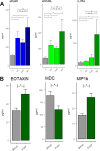Brain injury, endothelial injury and inflammatory markers are elevated and express sex-specific alterations after COVID-19
- PMID: 34838058
- PMCID: PMC8627162
- DOI: 10.1186/s12974-021-02323-8
Brain injury, endothelial injury and inflammatory markers are elevated and express sex-specific alterations after COVID-19
Abstract
Objective: Although COVID-19 is a respiratory disease, all organs can be affected including the brain. To date, specific investigations of brain injury markers (BIM) and endothelial injury markers (EIM) have been limited. Additionally, a male bias in disease severity and mortality after COVID-19 is evident globally. Sex differences in the immune response to COVID-19 may mediate this disparity. We investigated BIM, EIM and inflammatory cytokine/chemokine (CC) levels after COVID-19 and in across sexes.
Methods: Plasma samples from 57 subjects at < 48 h of COVID-19 hospitalization, and 20 matched controls were interrogated for the levels of six BIMs-including GFAP, S100B, Syndecan-1, UCHLI, MAP2 and NSE, two EIMs-including sICAM1 and sVCAM1. Additionally, several cytokines/chemokines were analyzed by multiplex. Statistical and bioinformatics methods were used to measure differences in the marker profiles across (a) COVID-19 vs. controls and (b) men vs. women.
Results: Three BIMs: MAP2, NSE and S100B, two EIMs: sICAM1 and sVCAM1 and seven CCs: GRO IL10, sCD40L, IP10, IL1Ra, MCP1 and TNFα were significantly (p < 0.05) elevated in the COVID-19 cohort compared to controls. Bioinformatics analysis reveal a stronger positive association between BIM/CC/EIMs in the COVID-19 cohort. Analysis across sex revealed that several BIMs and CCs including NSE, IL10, IL15 and IL8 were significantly (p < 0.05) higher in men compared to women. Men also expressed a more robust BIM/ EIM/CC association profile compared to women.
Conclusion: The acute elevation of BIMs, CCs, and EIMs and the robust associations among them at COVID-19 hospitalization are suggestive of brain and endothelial injury. Higher BIM and inflammatory markers in men additionally suggest that men are more susceptible to the risk compared to women.
Keywords: Brain injury; COVID-19; Endothelial injury; Inflammation; SARS-CoV-2; Sex differences.
© 2021. The Author(s).
Conflict of interest statement
The authors declare that they have no conflict of interest.
Figures



References
-
- Lee Y, Min P, Lee S, Kim S-W. Prevalence and duration of acute loss of smell or taste in COVID-19 patients. J Korean Med Sci [Internet]. 2020. https://www.ncbi.nlm.nih.gov/pmc/articles/PMC7211515/. - PMC - PubMed
-
- Russell B, Moss C, Rigg A, Hopkins C, Papa S, Hemelrijck MV. Anosmia and ageusia are emerging as symptoms in patients with COVID-19: what does the current evidence say? [Internet]. 2020. http://ecancer.org/en/journal/editorial/98-anosmia-and-ageusia-are-emerg.... - PMC - PubMed
-
- Vaira LA, Salzano G, Deiana G, De Riu G. Anosmia and Ageusia: Common Findings in COVID‐19 Patients. Laryngoscope [Internet]. 2020. https://www.ncbi.nlm.nih.gov/pmc/articles/PMC7228304/. - PMC - PubMed
MeSH terms
Substances
Grants and funding
LinkOut - more resources
Full Text Sources
Medical
Miscellaneous

